- Local time
- Today, 08:50
- Joined
- Jan 5, 2006
- Messages
- 54,120
- Points
- 1,327
- First Name
- Dave
- My Ride
- Speedmaster
- Riding Since
- 1974
Ten years ago the Bonneville turned 50. Should Triumph get to celebrate these milestones, even though it’s the reincarnation of the deceased original? The answer is of course it should: Resurrecting a dead thing from the ashes is the sincerest form of corporate loyalty. Such a quaint concept. Render unto Bloor what is Bloor’s.
2009 Triumph Bonneville Review
Fun at 50!
By Pete Brissette Apr. 02, 2009
Photos by Riles and Nelson
One definition of an icon is something that is an important, enduring symbol. In the motorcycle universe, few machines fit that definition as well – but not necessarily better – than the Triumph Bonneville. Another definition of an icon is a person who is “the object of great attention and devotion.” Indeed, many fans of Triumph love their Bonnies so much as to personify the machine, pay homage to it and worship at the alter of the British Twin.The Bonneville struck a chord with riders when it was introduced in 1959 as the T120 – essentially a twin-carb version of the T110 Tiger – and it remained a constant in the line-up until Triumph’s closure in 1983. In 2000, just 10 years after the marquee Brit brand was resurrected by John Bloor, the irrepressible Twin rose from the ashes, and today celebrates 50 years as Triumph model.
The original Bonnie received pivotal updates and enhancements in 1969; key among them was improved carburetion. Like its 1969 ancestor, the 2009 Bonneville has received a major update where petrol mixes with air. Instead of improved carbs, EFI is the name of the game. Fuel-injection is now standard across the entire line of what Triumph calls the Modern Classics: all three versions of the Bonneville, as well as the Thruxton and Scrambler.
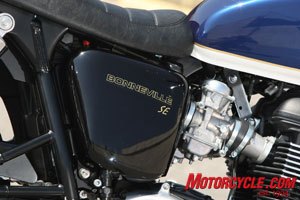 There’s no gasolina swishing around in the float bowls of those Keihin “carbs,” just wires and microchips.
There’s no gasolina swishing around in the float bowls of those Keihin “carbs,” just wires and microchips.
Fuel injection on the Modern Classics was made available for Europe in late 2007 as early release ’08 models according to Triumph staff, and the driving force for its implementation is greening up. The Keihin/Triumph EFI collaboration resulted in a system that’s allegedly five times cleaner burning and more fuel efficient than carbs.
That’s nice ‘n’ all for the trees and fishes, but what’s most interesting is how Keihin hides virtually every component of the fuel injection system within what is, by all outward appearances, a pair of basic-looking constant velocity carburetors. Only upon close inspection can you notice a couple of suspicious wires and electrical connectors.
These new carbs… er, um… injectors feed the 865cc (90 x 68mm), DOHC, air-cooled Parallel Twin that powers all the Modern Classics. On all three Bonnevilles claimed output is 67 hp at 7,500 rpm and 51 ft-lbs at 5,800 rpm while the modern café racer Thruxton produces 69 hp at 7,400 rpm and 52 ft-lbs at 6,800 rpm. In the Scrambler, the Twin fires at 270 degrees (360 on Bonnies and Thruxton) for a more unique exhaust note, and churns out 59 hp at 6,800 rpm with 51 ft-lbs coming in much lower at 4,700 rpm.
The T100, introduced in 2001 in honor of 100 years of Triumph, remains in the ’09 line as the version that harkens most clearly to 1960s Bonnies, which according to Triumph North America’s Jim Callahan, appeals to riders who still appreciate and identify – or want to identify – with the original Bonnevilles. It’s largely unchanged from 2008 save for the aforementioned EFI.
The T100 still rolls on spoke wheels and continues use of a 19-inch front wheel. This old schooler also touts chrome engine cases, two-tone paint, a seat incorporating the Triumph logo, fuel tank with Triumph badge and rubber knee pads just like days of yore, fork gators, “peashooter” exhaust and tachometer. The 2009 T100 retails for $8,799 and is available in color schemes Jet Black/Fusion White, Claret/Aluminum or Forest Green/New England White.
The new old kids on the block
Like last year, the current Bonneville line consists of three models, but this year two of three are distinctly different. The more basic Bonneville and snazzier Bonneville SE now have cast-aluminum17-inch wheels front and rear, and borrow the Thruxton’s shorter front fender as well as its exhaust. The new wheels and fender save over 18 pounds according to Triumph.
A lower seat height (29.1” v 30.5”) is achieved by use of the smaller diameter front wheel, reduced rear suspension travel (100 v 106mm) and a seat roughly 10mm thinner. Other ergo changes include handlebars 22mm closer, 21mm lower, and diameter reduced from 25.4 to 22mm. Mirrors moved more outward (35mm per side) for improved visibility, clutch and brake levers are adjustable and the front brake master cylinder is now a separate unit rather than integrated.
The Bonneville has black engine case covers, speedo with basic warning lamps, comes in Jet Black or Fusion White and retails for $7,699. The $8,399 Bonneville SE tarts things up with satin finish engine cases, speedo/tach combo like the T100, Triumph tank badge, and two-tone fuel tank paint with hand-applied pin-stripe on the Pacific Blue/Fusion White color scheme. A more basic Jet Black color scheme is also available.
New Bonnies for a new generation
Callahan explains that the new models were introduced to attract a different buyer than those interested in the Bonneville T100. The new Bonnies still offer much in the way of nostalgia, but also strike a sleeker, slightly modern stance. The updated look and tighter ergos reach out to a younger crowd while at the same time welcoming the expanding U.S. female rider demographic, and/or altogether new rider.
Hop from the T100 to the new bikes and the lower seat and closer handlebar should be evident even to the rookie. The new Bonnies genuinely feel like smaller bikes: Putting both feet flat at a stop is effortless, and even if you’ve an inseam less than 30 inches, the now narrower front portion of the one-piece saddle should make getting a foot down easier. Despite the shorter height, seat-to-peg relation never occurred to me as cramped, however, riders approaching 6 feet tall may feel differently. Reach to the bars is easy and natural.
[TD]
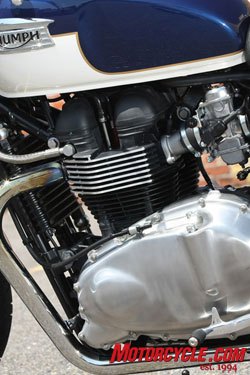 The famous Triumph parallel Twin that provides smooth, ample power. Satin finish engine cases are part of up-spec SE package.
The famous Triumph parallel Twin that provides smooth, ample power. Satin finish engine cases are part of up-spec SE package.
[/TD]
Immediately noticeable is neutral handling belying a claimed dry weight of 441 lbs. A lower center of gravity – thanks largely to the new 17-inch front wheel – should instill confidence in the new or returning rider. The smaller diameter front wheel and overall lighter wheels/fender combo pay dividends in quick, light steering. The new Bonneville and Bonneville SE are simply friendlier handling bikes compared to the heavier steering T100 with its 19-inch front wheel and additional 10 lbs weight penalty.
The thinner seat and shortened rear suspension travel make themselves known over rough pavement – particularly steep-angled bumps – with a sharp jolt now and then. The non-adjustable 41mm Kayaba fork with 4.7 inches of travel, and basic Kayaba preload adjustable dual coil-over spring shocks work well, but don’t expect a pillowy ride. Swapping out rides between the new models and the T100 with its identical suspension with 6mm more rear travel and thicker seat foam reveals a little more forgiveness from the nostalgic T100. Crummy pavement aside, the new Bonnevilles’ ride comfort is commendable, and decent overall chassis stability further builds rider confidence.
Though modernized with fuel-injection, any Modern Classic I rode was a tad cold-blooded, even with the mild temps we experienced during the press ride in the New Orleans area. Pulling out the enriching knob (think old school choke) on the left side of the faux carbs got the engine burbling, and within a couple minutes the bike was ready to ride.
Throttle response was very good save for what I perceived as some minor abruptness from closed to open throttle, though most noticeable just off idle. Some drive-line lash may have also contributed to this sensation. Otherwise, power is plentiful – even in top-gear for overtaking on the freeway. The engine spools up in a remarkably linear pattern, precisely what many new riders need. But even if you’re a salty vet like me, a smooth engine and predictable throttle response are always appreciated.
Clutch lever effort is light, and the 5-speed gear box rivals many refined Japanese machines for transparency and positive engagement. Click ‘n’ go! The brakes are another high-scoring component. The 2-piston sliding-pin Nissin front caliper grabs a single 310mm disc with authority and excellent feel; performance not usually experienced on such a basic brake, only on better 4-piston units.
Welcome to the future… at 50!
At the end of the day I came away with a single thought that encompassed my entire experience aboard the kinder, gentler Bonnies: nice bike! The new Bonnevilles brought me back to a place where riding for the sake of riding is simple fun. Assessed in whole, there’s little to find fault with in the 2009 Bonneville and Bonneville SE.
Experienced riders will appreciate having the venerated Triumph name, sans oil leaks and wonky electrics of old, in the form of any of the Bonnies. And new, short-stature or women riders have a very classy and exceptionally welcoming alternative to offerings from Japan and the U.S.
Related Reading
News on 2009 Triumph Modern Classics
2009 Triumph Models Announced
All things Triumph on Motorcycle.com
The post Church of MO: 2009 Triumph Bonneville appeared first on Motorcycle.com.
Source...
2009 Triumph Bonneville Review
Fun at 50!
By Pete Brissette Apr. 02, 2009
Photos by Riles and Nelson
One definition of an icon is something that is an important, enduring symbol. In the motorcycle universe, few machines fit that definition as well – but not necessarily better – than the Triumph Bonneville. Another definition of an icon is a person who is “the object of great attention and devotion.” Indeed, many fans of Triumph love their Bonnies so much as to personify the machine, pay homage to it and worship at the alter of the British Twin.The Bonneville struck a chord with riders when it was introduced in 1959 as the T120 – essentially a twin-carb version of the T110 Tiger – and it remained a constant in the line-up until Triumph’s closure in 1983. In 2000, just 10 years after the marquee Brit brand was resurrected by John Bloor, the irrepressible Twin rose from the ashes, and today celebrates 50 years as Triumph model.
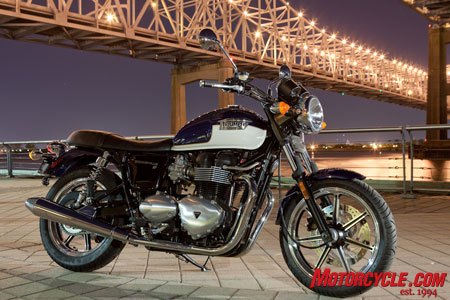
|
The original Bonnie received pivotal updates and enhancements in 1969; key among them was improved carburetion. Like its 1969 ancestor, the 2009 Bonneville has received a major update where petrol mixes with air. Instead of improved carbs, EFI is the name of the game. Fuel-injection is now standard across the entire line of what Triumph calls the Modern Classics: all three versions of the Bonneville, as well as the Thruxton and Scrambler.
| Carb Foolery |
 There’s no gasolina swishing around in the float bowls of those Keihin “carbs,” just wires and microchips.
There’s no gasolina swishing around in the float bowls of those Keihin “carbs,” just wires and microchips.Fuel injection on the Modern Classics was made available for Europe in late 2007 as early release ’08 models according to Triumph staff, and the driving force for its implementation is greening up. The Keihin/Triumph EFI collaboration resulted in a system that’s allegedly five times cleaner burning and more fuel efficient than carbs.
That’s nice ‘n’ all for the trees and fishes, but what’s most interesting is how Keihin hides virtually every component of the fuel injection system within what is, by all outward appearances, a pair of basic-looking constant velocity carburetors. Only upon close inspection can you notice a couple of suspicious wires and electrical connectors.
These new carbs… er, um… injectors feed the 865cc (90 x 68mm), DOHC, air-cooled Parallel Twin that powers all the Modern Classics. On all three Bonnevilles claimed output is 67 hp at 7,500 rpm and 51 ft-lbs at 5,800 rpm while the modern café racer Thruxton produces 69 hp at 7,400 rpm and 52 ft-lbs at 6,800 rpm. In the Scrambler, the Twin fires at 270 degrees (360 on Bonnies and Thruxton) for a more unique exhaust note, and churns out 59 hp at 6,800 rpm with 51 ft-lbs coming in much lower at 4,700 rpm.
The T100, introduced in 2001 in honor of 100 years of Triumph, remains in the ’09 line as the version that harkens most clearly to 1960s Bonnies, which according to Triumph North America’s Jim Callahan, appeals to riders who still appreciate and identify – or want to identify – with the original Bonnevilles. It’s largely unchanged from 2008 save for the aforementioned EFI.
The T100 still rolls on spoke wheels and continues use of a 19-inch front wheel. This old schooler also touts chrome engine cases, two-tone paint, a seat incorporating the Triumph logo, fuel tank with Triumph badge and rubber knee pads just like days of yore, fork gators, “peashooter” exhaust and tachometer. The 2009 T100 retails for $8,799 and is available in color schemes Jet Black/Fusion White, Claret/Aluminum or Forest Green/New England White.
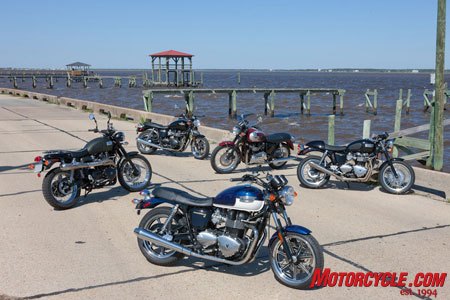
|
The new old kids on the block
Like last year, the current Bonneville line consists of three models, but this year two of three are distinctly different. The more basic Bonneville and snazzier Bonneville SE now have cast-aluminum17-inch wheels front and rear, and borrow the Thruxton’s shorter front fender as well as its exhaust. The new wheels and fender save over 18 pounds according to Triumph.
A lower seat height (29.1” v 30.5”) is achieved by use of the smaller diameter front wheel, reduced rear suspension travel (100 v 106mm) and a seat roughly 10mm thinner. Other ergo changes include handlebars 22mm closer, 21mm lower, and diameter reduced from 25.4 to 22mm. Mirrors moved more outward (35mm per side) for improved visibility, clutch and brake levers are adjustable and the front brake master cylinder is now a separate unit rather than integrated.
The Bonneville has black engine case covers, speedo with basic warning lamps, comes in Jet Black or Fusion White and retails for $7,699. The $8,399 Bonneville SE tarts things up with satin finish engine cases, speedo/tach combo like the T100, Triumph tank badge, and two-tone fuel tank paint with hand-applied pin-stripe on the Pacific Blue/Fusion White color scheme. A more basic Jet Black color scheme is also available.
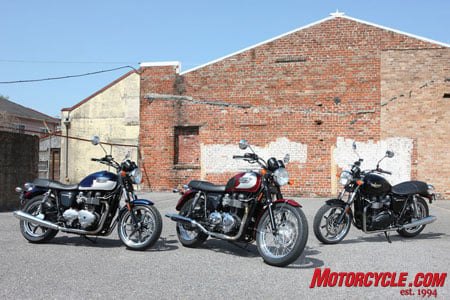
|
New Bonnies for a new generation
Callahan explains that the new models were introduced to attract a different buyer than those interested in the Bonneville T100. The new Bonnies still offer much in the way of nostalgia, but also strike a sleeker, slightly modern stance. The updated look and tighter ergos reach out to a younger crowd while at the same time welcoming the expanding U.S. female rider demographic, and/or altogether new rider.
Hop from the T100 to the new bikes and the lower seat and closer handlebar should be evident even to the rookie. The new Bonnies genuinely feel like smaller bikes: Putting both feet flat at a stop is effortless, and even if you’ve an inseam less than 30 inches, the now narrower front portion of the one-piece saddle should make getting a foot down easier. Despite the shorter height, seat-to-peg relation never occurred to me as cramped, however, riders approaching 6 feet tall may feel differently. Reach to the bars is easy and natural.
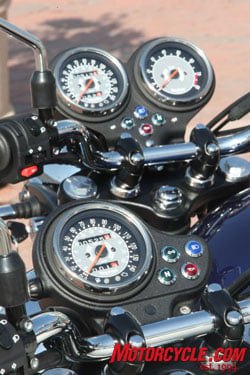
|
[TD]

[/TD]
Immediately noticeable is neutral handling belying a claimed dry weight of 441 lbs. A lower center of gravity – thanks largely to the new 17-inch front wheel – should instill confidence in the new or returning rider. The smaller diameter front wheel and overall lighter wheels/fender combo pay dividends in quick, light steering. The new Bonneville and Bonneville SE are simply friendlier handling bikes compared to the heavier steering T100 with its 19-inch front wheel and additional 10 lbs weight penalty.
The thinner seat and shortened rear suspension travel make themselves known over rough pavement – particularly steep-angled bumps – with a sharp jolt now and then. The non-adjustable 41mm Kayaba fork with 4.7 inches of travel, and basic Kayaba preload adjustable dual coil-over spring shocks work well, but don’t expect a pillowy ride. Swapping out rides between the new models and the T100 with its identical suspension with 6mm more rear travel and thicker seat foam reveals a little more forgiveness from the nostalgic T100. Crummy pavement aside, the new Bonnevilles’ ride comfort is commendable, and decent overall chassis stability further builds rider confidence.
Though modernized with fuel-injection, any Modern Classic I rode was a tad cold-blooded, even with the mild temps we experienced during the press ride in the New Orleans area. Pulling out the enriching knob (think old school choke) on the left side of the faux carbs got the engine burbling, and within a couple minutes the bike was ready to ride.
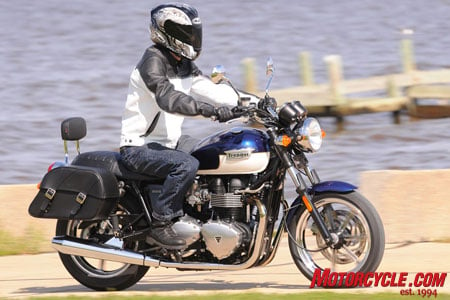
|
Throttle response was very good save for what I perceived as some minor abruptness from closed to open throttle, though most noticeable just off idle. Some drive-line lash may have also contributed to this sensation. Otherwise, power is plentiful – even in top-gear for overtaking on the freeway. The engine spools up in a remarkably linear pattern, precisely what many new riders need. But even if you’re a salty vet like me, a smooth engine and predictable throttle response are always appreciated.
Clutch lever effort is light, and the 5-speed gear box rivals many refined Japanese machines for transparency and positive engagement. Click ‘n’ go! The brakes are another high-scoring component. The 2-piston sliding-pin Nissin front caliper grabs a single 310mm disc with authority and excellent feel; performance not usually experienced on such a basic brake, only on better 4-piston units.
Welcome to the future… at 50!
At the end of the day I came away with a single thought that encompassed my entire experience aboard the kinder, gentler Bonnies: nice bike! The new Bonnevilles brought me back to a place where riding for the sake of riding is simple fun. Assessed in whole, there’s little to find fault with in the 2009 Bonneville and Bonneville SE.
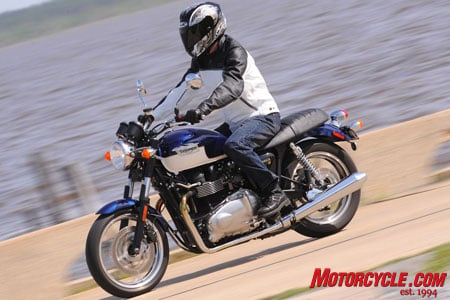
|
Experienced riders will appreciate having the venerated Triumph name, sans oil leaks and wonky electrics of old, in the form of any of the Bonnies. And new, short-stature or women riders have a very classy and exceptionally welcoming alternative to offerings from Japan and the U.S.
Related Reading
News on 2009 Triumph Modern Classics
2009 Triumph Models Announced
All things Triumph on Motorcycle.com
The post Church of MO: 2009 Triumph Bonneville appeared first on Motorcycle.com.
Source...

